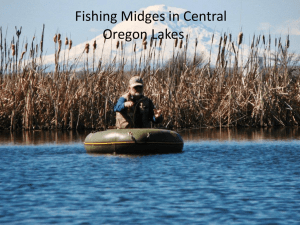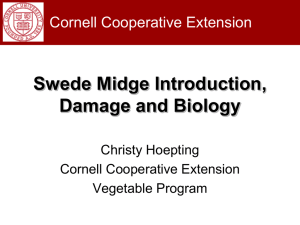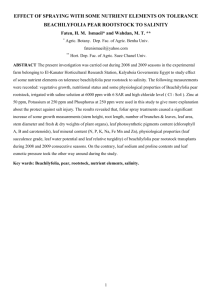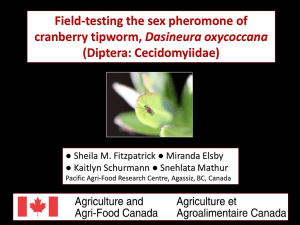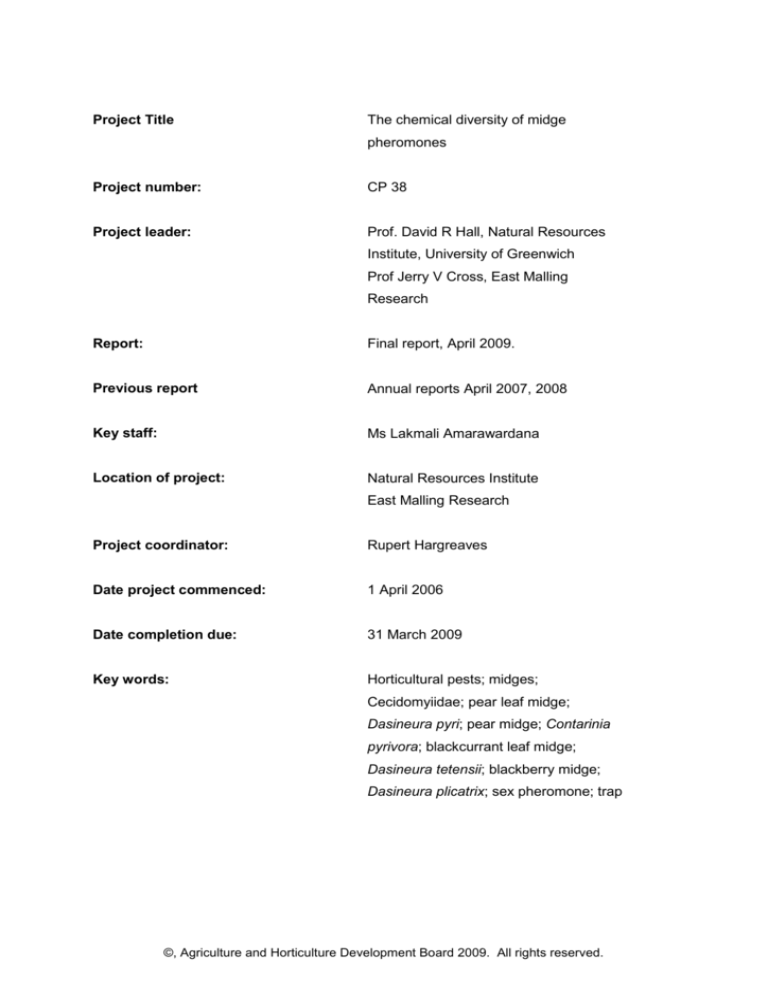
Project Title
The chemical diversity of midge
pheromones
Project number:
CP 38
Project leader:
Prof. David R Hall, Natural Resources
Institute, University of Greenwich
Prof Jerry V Cross, East Malling
Research
Report:
Final report, April 2009.
Previous report
Annual reports April 2007, 2008
Key staff:
Ms Lakmali Amarawardana
Location of project:
Natural Resources Institute
East Malling Research
Project coordinator:
Rupert Hargreaves
Date project commenced:
1 April 2006
Date completion due:
31 March 2009
Key words:
Horticultural pests; midges;
Cecidomyiidae; pear leaf midge;
Dasineura pyri; pear midge; Contarinia
pyrivora; blackcurrant leaf midge;
Dasineura tetensii; blackberry midge;
Dasineura plicatrix; sex pheromone; trap
©, Agriculture and Horticulture Development Board 2009. All rights reserved.
DISCLAIMER
AHDB, operating through its HDC division seeks to ensure that the information contained
within this document is accurate at the time of printing. No warranty is given in respect
thereof and, to the maximum extent permitted by law the Agriculture and Horticulture
Development Board accepts no liability for loss, damage or injury howsoever caused
(including that caused by negligence) or suffered directly or indirectly in relation to
information and opinions contained in or omitted from this document.
Copyright, Agriculture and Horticulture Development Board 2009. All rights reserved.
No part of this publication may be reproduced in any material form (including by photocopy
or storage in any medium by electronic means) or any copy or adaptation stored, published
or distributed (by physical, electronic or other means) without the prior permission in writing
of the Agriculture and Horticulture Development Board, other than by reproduction in an
unmodified form for the sole purpose of use as an information resource when the Agriculture
and Horticulture Development Board or HDC is clearly acknowledged as the source, or in
accordance with the provisions of the Copyright, Designs and Patents Act 1988. All rights
reserved.
AHDB (logo) is a registered trademark of the Agriculture and Horticulture Development
Board.
HDC is a registered trademark of the Agriculture and Horticulture Development Board, for
use by its HDC division.
All other trademarks, logos and brand names contained in this publication are the
trademarks of their respective holders.
No rights are granted without the prior written
permission of the relevant owners.
©, Agriculture and Horticulture Development Board 2009. All rights reserved.
AUTHENTICATION
We declare that this work was done under our supervision according to the procedures
described herein and that the report represents a true and accurate record of the results
obtained.
Prof David R Hall
Professor of Chemical Ecology
Natural Resources Institute, University of Greenwich
Signature ............................................................
Date ............................................
Prof Jerry V Cross
Research Leader
East Malling Research
Signature ............................................................
Date ............................................
Report authorised by:
[Name]
[Position]
[Organisation]
Signature ............................................................
Date ............................................
[Name]
[Position]
[Organisation]
Signature ............................................................
Date ............................................
©, Agriculture and Horticulture Development Board 2009. All rights reserved.
CONTENTS
Page
Grower Summary
Headline
1
Background and expected deliverables
1
Summary of the project and main conclusions
2
Financial benefits
6
Action points for growers
6
©, Agriculture and Horticulture Development Board 2009. All rights reserved.
GROWER SUMMARY
Headline
This project has identified and synthesised the major components of the female sex
pheromones of the pear leaf midge, the pear midge and the blackcurrant leaf midge, with
lures now being made available to growers for pest monitoring.
Background and expected deliverables
Many horticultural crops, especially perennial fruit crops, are subject to pest attack by
various species of leaf-curling or other gall midges (Diptera: Cecidomyiidae). Some species
are currently controlled with broad-spectrum organophosphate or pyrethroid insecticides, but
use of these is undesirable because they may be harmful and toxic and will disrupt
integrated pest management. These midges are therefore likely to continue as significant
pests and will affect the economic viability of their host crops. For other species, such as the
apple and pear leaf midges, there are currently no effective control methods and they cause
extensive damage, especially in nurseries and young orchards. Alternative, non-pesticidal
control methods are required.
Plant-feeding midges are typically very short-lived as adults and are highly specific to their
host-crop.
In several species there is evidence for production of highly potent sex
pheromones by virgin female adults and strong attraction of mated females to volatiles from
host plants. Identification of these attractants could provide a means of manipulating pest
behaviour at critical stages in their life cycle. However, identification of the attractants has
proved extremely challenging due to the very small amounts of chemical involved and the
difficulties of carrying out laboratory bioassays with these small and delicate insects.
The pheromones of midge species identified previously are molecules with a linear chain of
an odd number of carbon atoms with one or two ester functionalities, neither at the ends of
the carbon chain. In recent work at NRI and EMR the pheromones of the apple leaf midge,
Dasineura mali and the raspberry cane midge, Resseliella theobaldi, were identified as
members of a novel group of ketoesters.
1
©, Agriculture and Horticulture Development Board 2009. All rights reserved.
The aim of this work is to further explore the chemical diversity of midge pheromones and
identify the midge pheromones of importance to the UK horticulture industry. These include
the pear leaf midge, D. pyri, the pear midge, Contarinia pyrivora, the blackcurrant leaf midge,
D. tetensi, and the blackberry midge, D. plicatrix.
The project will deliver:
synthetic pheromone lures for the above species for use by growers in
monitoring of these pests;
potential for control of these pests using the pheromones for mass trapping,
mating disruption or lure-and-kill approaches;
further information on the chemical diversity and patterns in midge
pheromones, that may assist in identification of the chemical structures of
pheromones of other midge species.
Summary of the project and main conclusions
Summary
The project has investigated the female sex pheromones of four species of midge which are
important pests of horticultural crops in the UK. These are the pear leaf midge, Dasineura
pyri, the pear midge, Contarinia pyrivora, the blackcurrant leaf midge, D. tetensii, and the
blackberry midge, D. plicatrix. For the first three of these, components of the female sex
pheromones have been identified and synthesised, and lures containing only a few
micrograms of the synthetic pheromone have been shown to be highly attractive to
conspecific male midges in field trapping experiments. Significant progress has been made
on identification of two components of the female sex pheromone of the blackberry midge,
but this is not yet complete.
New techniques for pheromone research
In achieving these results, the project has made significant advances in improving several of
the techniques used in isolation and identification of pheromones, particularly those of
midges.
Collection of insects - Previously midge pupae have been isolated by timeconsuming sieving of soil. In this project, large numbers of insects were collected
2
©, Agriculture and Horticulture Development Board 2009. All rights reserved.
relatively easily as late larvae in galls, and reared to adults in individual tubes to
ensure they were unmated – e.g. 20,000 pear leaf midge larvae were collected.
Collection of pheromone - Other workers have collected pheromones by dissecting
out the pheromone glands and extracting them with solvent. This is difficult and timeconsuming and introduces impurities which interfere with the analysis. In this project,
pheromones were collected by trapping the volatiles emitted by the insects on a solid
adsorbent. Large numbers of insects can easily be processed and the collections
are cleaner and can be concentrated without interfering with the analysis. This is
particularly important with midge pheromones that are generally produced in very
small quantities, typically less than 10-9 gm per insect.
Electroantennography (EAG) - In this project, pheromone components were
detected by electrophysiological recording of the responses from an insect antenna
when exposed to the pheromone collections. This is obviously a challenge with such
small, delicate insects. Various approaches are described in the literature, and a
convenient, reproducible technique was developed during this work which is
applicable to a wide range of midges and similar small insects.
Separation of stereoisomers -The pheromone components identified in this project
consist of two or four stereoisomers, and it is very time consuming to synthesise all
the individual stereoisomers in pure state for field testing.
In this project, high
performance liquid chromatography (HPLC) with a chiral column was developed as a
very convenient method for separating and isolating the individual isomers from the
racemic mixture of all the isomers.
Progress on pheromone identification
Pear leaf midge, D. pyri
Over 20,000 larvae were collected in the UK and New Zealand, although only about 30%
survived to adulthood.
Volatiles were collected separately from virgin male and female
insects. Two potential pheromone components were detected in analyses of volatiles from
female midges by gas chromatography (GC) coupled to EAG recording from a male midge.
The major component was identified as (Z)-2,13-diacetoxy-8-heptadecene by interpretation
of the mass spectrum and comparison of GC retention times with those of a large library of
standards. The minor component was present in very small quantities and could not be
identified.
3
©, Agriculture and Horticulture Development Board 2009. All rights reserved.
The major component was synthesised at NRI in 10 steps as the racemic mixture of all four
stereoisomers, but this did not attract any male pear leaf midge when tested as a lure in
traps in pear orchards. The four stereoisomers were separated by HPLC as above and the
one eluting first, proved to be highly attractive to male pear leaf midge in field tests. The
other three isomers were not attractive, but when the second-eluting isomer was added to
the first it completely inhibited the attractiveness of the latter. Field tests were carried out in
both UK and New Zealand pear orchards with similar results.
It was possible to synthesise the stereoisomers of the analogue of the pheromone with no
double bond and comparison of these with the attractive isomer of the pheromone to
determine the absolute configuration showed that this was (2R,13R,8Z)-2,13-diacetoxy-8heptadecene. The inhibitory isomer was (2R,13S,8Z)-2,13-diacetoxy-8-heptadecene.
Pear midge, C. pyrivora
This was a very difficult insect to collect and rear, having only one generation per year.
However, sufficient adults were obtained to make collections of pheromone from virgin
females, and analysis of these by GC-EAG indicated the presence of two active components
that stimulated receptors on the antennae of males.
The most abundant of these was
identified as 2,7-diacetoxyundecane and the relatively minor component as 7-acetoxy-2undecanone. The compounds were synthesised at NRI in three and five steps respectively
and separated into four and two stereoisomers respectively by HPLC.
Two main field trapping tests were carried out during 2008. In both of these, the first eluting
isomer of the major component caught male pear midge. However, in the first test the fourth
isomer was also attractive whereas in the second test this was unattractive and the thirdeluting isomer was attractive. It was subsequently found that another species was also
caught in the traps. It was not then possible to go back to examine all the catches, but this
probably explains the anomalous results. A further experiment in 2009 confirmed that the
first and third eluting isomer are attractive. The racemic mixture of all four of the isomers of
the major component was not attractive, and this is probably due to the presence of the
second-eluting isomer. The minor pheromone component was also attractive, although less
so than the major component. In this case one of the two stereoisomers and the racemic
mixture of both were equally attractive. The other isomer was unattractive.
4
©, Agriculture and Horticulture Development Board 2009. All rights reserved.
Blackcurrant leaf midge, D. tetensii
Approximately 12,600 larvae were collected and 36% survived to adulthood. Volatiles were
collected from virgin females and analysed by GC-EAG.
Two active components were
detected and the most abundant of these was identified as (Z)-2,12-diacetoxy-8heptadecene which differs from the major component of the pheromone of the pear leaf
midge only in the position of the second acetate group which is shifted by one carbon atom.
Potential structures for the minor pheromone component have been proposed but not
confirmed.
The major pheromone component was synthesised at NRI in 10 steps and separated into its
four stereoisomers by HPLC. For this species, the third-eluting stereoisomer was highly
attractive to males. The other isomers were not attractive themselves and only had a weakly
inhibitory effect when mixed with the attractive isomer. Thus the racemic mixture of all four
stereoisomers is significantly attractive to male midges and can be used for monitoring this
pest.
Blackberry midge, D. plicatrix
Approximately 10,000 larvae were collected from farms in UK and The Netherlands and
reared to adulthood. GC-EAG analyses of collection of pheromone from females indicated
the presence of two pheromone components. Identification of these is not yet complete but
preliminary work has demonstrated they are both 15-carbon compounds with an acetate
group in the 2-position. The major component probably has two double bonds and the minor
component one, but the positions and configurations of these have not been established.
Pheromone structures
All the pheromone components are novel structures, but they conform to patterns emerging
as more midge pheromones are identified. They all have an odd number of carbon atoms,
although the components of the pheromone of the blackberry midge are the first to be
identified with 15 carbon atoms. All have an oxygenated functionality in the 2-position.
Some have another oxygenated functionality, as in the di-acetates and ketoacetates, and
some have one or two double bonds, but the positions and configurations of these are much
more variable.
Interestingly, one other example of the new ketoacetate structure was
discovered in this work – the minor pheromone component of the pear midge.
5
©, Agriculture and Horticulture Development Board 2009. All rights reserved.
Further work
For pear leaf midge, small numbers of lures can be made available to growers for
monitoring using HPLC to separate the stereoisomers. Now we know the absolute
configurations of the isomers, development of a route for synthesising the attractive
stereoisomer uncontaminated by the inhibitory isomer is required..
Similarly for pear midge, small numbers of lures containing the attractive isomer of
the major pheromone component only, can be made available. Further work is
required to establish the absolute configuration of this compound, but synthesis
should be relatively straightforward for this pheromone.
Lures containing the attractive stereoisomer of the pheromone of the blackcurrant
leaf midge have been deployed by 8 growers during 2009 to monitor the pest.
Further work is required to determine the absolute configuration of the attractive
isomer and develop a synthetic route to the attractive isomer.
Further work is required to complete identification of the two components of the
pheromone of the blackberry midge.
For all these species, further work is required to calibrate trap catches against
populations of the midge and the damage it causes. As indicated, this work is in
progress with growers for the blackcurrant midge.
Financial benefits
The four midges are pests of their respective host crops, the blackcurrant leaf midge being
particularly commercially important. As lures continue to be made commercially available to
growers, they will gain financial benefit from improved monitoring and better targeted use of
pesticides, leading to improved control.
Action points for growers
Subject to at least some of the further work above being completed, it is
hoped to make the sex pheromone traps available commercially to growers.
6
©, Agriculture and Horticulture Development Board 2009. All rights reserved.
These pheromone traps can be used to determine the phenology and
relative abundance of the different species in different crops, and will be
useful for timing insecticide sprays for control.
7
©, Agriculture and Horticulture Development Board 2009. All rights reserved.

